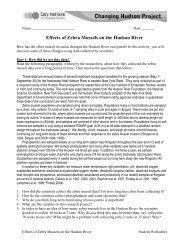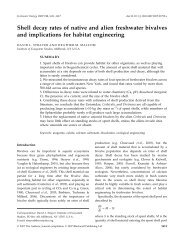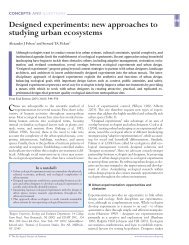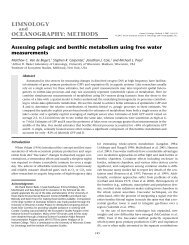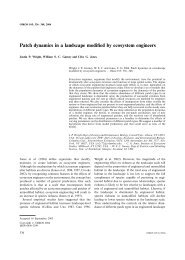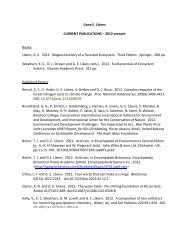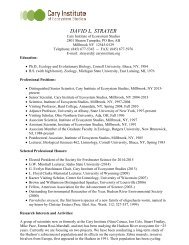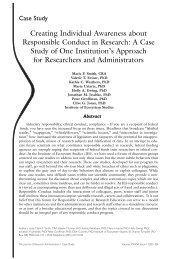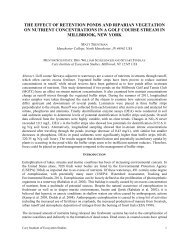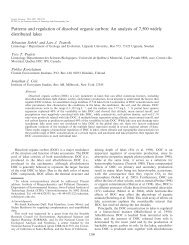Biennial Report Book 2007.indb - Cary Institute of Ecosystem Studies
Biennial Report Book 2007.indb - Cary Institute of Ecosystem Studies
Biennial Report Book 2007.indb - Cary Institute of Ecosystem Studies
Create successful ePaper yourself
Turn your PDF publications into a flip-book with our unique Google optimized e-Paper software.
<strong>Institute</strong> <strong>of</strong> <strong>Ecosystem</strong> <strong>Studies</strong>A Scientific Review, 2005 - 2007AIRThe <strong>Institute</strong> has a strong history <strong>of</strong> analyzing how airborne pollutants impactecosystems. Research by the organization’s founder, Dr. Gene E. Likens, informedClean Air Act Amendments that have been instrumental in reducing acid rain.<strong>Institute</strong> scientists continue to explore how airborne pollutants influence theenvironment, with research sites worldwide, including New York’s Catskill Forest,Maine’s Acadia National Park, and southern Chile.Threats from above: Air pollution effects on biodiversityThe <strong>Institute</strong> provided leadership on a Nature Conservancy report detailing the impact<strong>of</strong> airborne pollutants (sulfur, nitrogen, ozone, and mercury) on plants and animals inthe Northeast and Mid-Atlantic States. All <strong>of</strong> the ecosystems studied were impacted,with many suffering damage from multiple pollutants. If species and habitats are tobe conserved, the report recommends that conservation organizations become moreinvolved in creating national air pollution policy. (Lovett)Nitrogen air pollution and tree mortality<strong>Institute</strong> researchers found that when trees are fertilized with nitrogen over a period<strong>of</strong> several years, they have an elevated mortality rate compared to unfertilized trees.While nitrogen is traditionally viewed as a plant fertilizer, this research suggests thatexcess nitrogen from air pollution may be harmful to forest ecosystems. (Lovett)LANDFrom the state <strong>of</strong> the world’s forests, to ecological conditions in urban areas, <strong>Institute</strong>scientists are actively investigating the terrestrial environment. Our research hasproduced a better understanding <strong>of</strong> invasive forest pests, ecological models thatfacilitate sustainable forestry, and predictions <strong>of</strong> how climate change will influenceforest function.Predicting forest response to exotic pests and pathogensExotic pests are one <strong>of</strong> the biggest threats facing forests in the Northeastern UnitedStates. To understand the scope <strong>of</strong> the problem, a team <strong>of</strong> <strong>Institute</strong> scientistsperformed an extensive review <strong>of</strong> the impacts that introduced insects and diseaseshave on forested ecosystems. The team developed a conceptual framework tohelp assess ecosystem-scale effects <strong>of</strong> invaders, and the findings were published inBioscience. (Lovett, Canham, Weathers)Understanding climate change impacts on forestsFor over 16 years, <strong>Institute</strong> research has been looking at forest structure inConnecticut’s Great Mountain Forest. Long-term research on tree competitiondynamics, published in Ecological Applications, has set the stage for understanding thepotential effects <strong>of</strong> climate change on both the demography and distribution <strong>of</strong> foresttrees. (Canham)4



